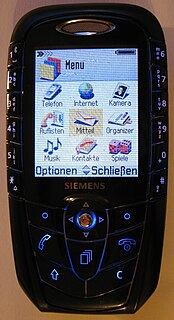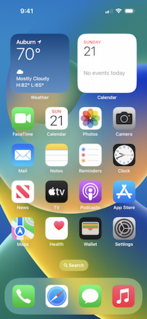Related Research Articles

The iPod is a discontinued series of portable media players and multi-purpose mobile devices designed and marketed by Apple Inc. The first version was released on October 23, 2001, about 8+1⁄2 months after the Macintosh version of iTunes was released. Apple sold an estimated 450 million iPod products as of 2022. Apple discontinued the iPod product line on May 10, 2022. At over 20 years, the iPod brand is the oldest to be discontinued by Apple.

The Siemens SX1 is a GSM mobile phone running version 1.2 of the Series 60 platform for the Symbian OS. It was the first such smartphone from Siemens following its licensing agreement with Nokia for the use and development of Series 60. Though unveiled in February 2003, it was not launched until December of that year.

Siemens Mobile was a German mobile phone manufacturer and a division of Siemens AG. Siemens sold Siemens Mobile to the Taiwan-based BenQ in 2005, subsequently becoming BenQ-Siemens and succeeded by Gigaset. The last Siemens-branded mobile phones, the AL21, A31 and AF51, were released in November 2005.

A portable media player (PMP) is a portable consumer electronics device capable of storing and playing digital media such as audio, images, and video files. The data is typically stored on a compact disc (CD), Digital Video Disc (DVD), Blu-ray Disc (BD), flash memory, microdrive, or hard drive; most earlier PMPs used physical media, but modern players mostly use flash memory. In contrast, analogue portable audio players play music from non-digital media that use analogue signal storage, such as cassette tapes or vinyl records.

The Motorola Razr is a series of mobile phones by Motorola, part of the 4LTR line. The V3 was the first phone shown in the series and was introduced in December 2003 and released in the market in the third quarter of 2004. The V3 model was followed soon thereafter by the improved V3i, including a collaboration with Apple Inc. for iTunes to be built-in. It was launched in 2006.
The Motorola ROKR, the first version of which was informally known as the iTunes phone, was a series of mobile phones from Motorola, part of a 4LTR line developed before the spin out of Motorola Mobility. ROKR models were released starting in September 2005 and ending in 2009. They were notable for incorporating support of media player features.
The Motorola Q is a Windows Mobile smartphone first announced in the Summer of 2005 as a thin device with similar styling to Motorola's immensely popular RAZR. Motorola in a partnership with Verizon Wireless released the Q on May 31, 2006. A version for Sprint was released early in January 2007 and one for Amp'd Mobile in April 2007.

BenQ Mobile GmbH & Co. OHG was the mobile communications subsidiary of Taiwanese BenQ Corporation, selling products under the BenQ-Siemens brand. The group, based in Munich, Germany, was formed out of BenQ's acquisition of the then struggling Siemens Mobile group in 2005. The newly formed company won the most iF product design awards in 2006 and also won many design awards in Germany's Red Dot competition. BenQ Mobile failed later that year.

The Siemens S55 was a mobile phone which was introduced by Siemens in late 2002. At the time it was a high end phone and one of the first colour phones by Siemens, with a 256 colour screen, Bluetooth and infrared, and a competitor to the Ericsson T68.

The Siemens S65 is a mobile phone by Siemens. It is bundled with a replaceable 32 MB MMC card. It also features a 1.3-megapixel digital camera. It was targeted to premium users.

The iPod Touch is a discontinued line of iOS-based mobile devices designed and marketed by Apple Inc. with a touchscreen-controlled user interface. As with other iPod models, the iPod Touch can be used as a music player and a handheld gaming device, but can also be used as a digital camera, a web browser and for messaging. It is similar in design to the iPhone, but it connects to the Internet only through Wi-Fi and does not use cellular network data, so it is not a smartphone.

The Siemens C65 is a mobile phone announced by Siemens. This phone is under “C-Class” leveling of Siemens for entry levels/ consumer regularly. Its been released in March 2004. It weighs 86 g and its dimensions are 100 x 45 x 16 mm. Its display is a 130x130 pixels, 65K colors CSTN LCD. Its carrier-engineered variants are Siemens CT65, CV65 and CO65, exclusively for three mainly mobile operators T-Mobile, Vodafone and O2 respectively. It is known in North America as the Siemens C66.
The LG Secret is a 3G slider-style mobile phone manufactured by LG Electronics. It is the third phone in LG's "Black Label Series", following the LG Chocolate and LG Shine. It was released on May 3, 2008 in Europe. It has a 5.0-megapixel camera and Neon touch navigation, and is notable for incorporating these in a slim slider form design.
MobileMe is a discontinued subscription-based collection of online services and software offered by Apple Inc. All services were gradually transitioned to and eventually replaced by the free iCloud, and MobileMe ceased on June 30, 2012, with transfers to iCloud being available until July 31, 2012, or data being available for download until that date, when the site finally closed completely. On that date all data was deleted, and email addresses of accounts not transferred to iCloud were marked as unused.

The Nokia 6280 Series, is a series of slider type phones first released in Q4, 2005.
The form factor of a mobile phone is its size, shape, and style, as well as the layout and position of its major components.

The iPhone 3GS is a smartphone that was designed and marketed by Apple Inc. It is the third generation iPhone and the successor to the iPhone 3G. It was unveiled on June 8, 2009 at the WWDC 2009 which took place at the Moscone Center in San Francisco.

The sixth generation iPod Touch is a mobile device designed and marketed by Apple Inc. with a touchscreen-based user interface. It is the successor to the iPod Touch, becoming the first major update to the iPod lineup in more than two and a half years. It was released on the online Apple Store on July 15, 2015, along with minor upgrades to the iPod Nano and iPod Shuffle. This generation of iPod Touch was officially discontinued by Apple on May 28, 2019, with the release of its next-generation successor. It supports up to iOS 12.5.6, released on August 31, 2022.

Pre-installed iOS apps, referred to in the App Store as 'Built-In Apps', are a suite of mobile applications developed by Apple Inc. which are bundled with iOS and installed by default or through a system update. Many of the default apps found on iOS have counterparts on Apple's other operating systems macOS, iPadOS, watchOS, and tvOS, which are often modified versions of or similar to the iOS application. As each app is integrated into the operating system itself, they often feature greater support for system features than third-party alternatives and are quick to adapt new features of iOS.
The iPhone's hardware is designed by Apple Inc. Apple directly sub-contracts hardware production to external OEM companies, maintaining a high degree of control over the end product.